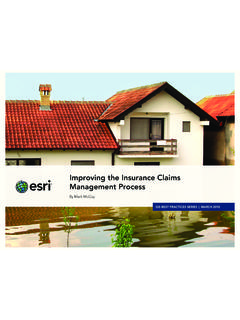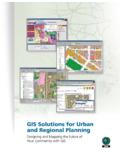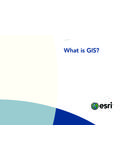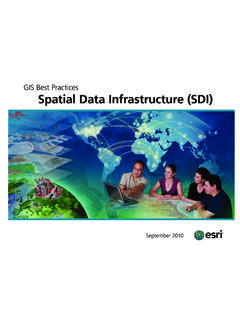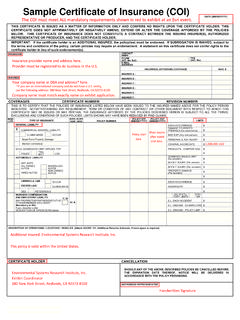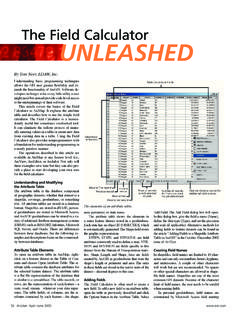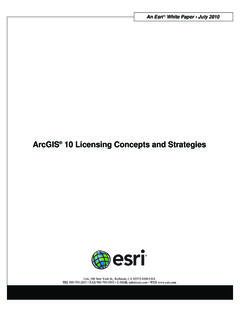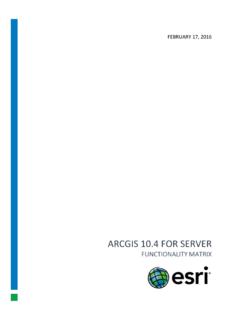Transcription of Geographic Inquiry: Thinking Geographically
1 Geographic Inquiry: Thinking Geographically ESRI Schools and Libraries Program Copyright 2003 ESRI, Inc. Geography is the study of the world and all that is in it: its peoples, its land, air, and water, its plants and animals, and all the connections among its various parts. When you are investigating the world and its events you are dealing with geography. As you move through space in your everyday life you are observing and interacting with geography and making Geographic decisions based on those encounters. You may not be aware of it but you are involved in Geographic inquiry. This mode of Thinking is not unlike other research-oriented approaches, such as the scientific method; however, it has one big difference: space.
2 Knowing where something is, how its location influences its characteristics, and how its location influences relationships with other phenomena are the foundation of Geographic Thinking . This mode of investigation asks you to see the world and all that is in it in spatial terms. Like other research methods, it also asks you to explore, analyze, and act upon the things you find. It also is important to recognize that this is the same method used by professionals around the world working to address social, economic, political, environmental, and a range of scientific issues. They, like you, have geography and GIS as key organizers. So, what are the steps of Geographic inquiry? 1. Ask Geographic questions 2.
3 Acquire Geographic resources 3. Explore Geographic data 4. Analyze Geographic information 5. Act upon Geographic knowledge Let's clarify them. 1. Ask Geographic questions Think about a topic or place, and identify something interesting or significant about it. Spin that observation into the form of a question, such as "Why do these particular trees show signs of stress? or "How do the types of businesses change as we move along this street? or "What does it matter if that whole area is cleared of trees?" By turning the interesting observation into a question, you can focus the exploration. Good Geographic questions range from the simple "Where are things?" to "How do things change between here and there?
4 " to deeper questions, such as "Why does this thing change between here and there?" or What is the result of this thing changing between here and there?" Thus, you might be tempted to ask "Where do songbirds nest? or "Why is there drought in this region while that region is flooded? or "What is the result of refugees moving from this land across the border to that place?" A good question sets up the exploration. 2. Acquire Geographic resources Once you have a question, you can think about the information needed to answer it. Here, it s helpful to consider at least three aspects of the issue: geography, time, and subject. What's the Geographic focus of your research? In studying a country in relation to others, your inquiry might require country-level data, and you would need data for the country of interest as well as for neighboring countries.
5 Defining the Geographic focus helps you define the scale (global, regional, local) of your inquiry, and helps you define the extent (a city, a country, a continent, the globe) of your inquiry. For what period of time do you need the data? Answering questions of today would sensibly mean using information about the present or a very recent time. However, those questions could gain greater clarity by including a historical or future perspective. Alternatively, a question focused on past events requires historical rather than contemporary data. For what subject(s) and specific topics do you need data? This may sound silly but it is very useful to take time to consider the topical aspects of the data needed.
6 Population may be the general nature of your study but international migration may be your actual focus. Learn to dissect your data needs. The more specific you can be in defining your focus, the less likely you are to get lost in piles of unrelated and unnecessary data. Often, you can find the necessary Geographic data quite easily, in readily available packages or downloadable from the Internet. Sometimes you have to produce the data yourself, or convert data from one form into a more appropriate form. In the early days of GIS, almost all data had to be produced independently. These days, the explosion of technology and rise of the Internet has made it much easier to acquire information. This explosion of data means you may find material in a wide range of formats, at multiple scales, with variable quality.
7 After tracking down what is readily accessible, and recording any source information about your data, you need to look at what is still missing and decide if you can answer your question. Even if you are missing some desired data, you may still be able to answer your initial question, or a variation of it, by exploring your resources carefully. 2. Geographic Inquiry: Thinking Geographically Copyright 2003 ESRI Schools and Libraries Program 3. Explore Geographic data Turn the data into maps, tables, and charts. Maps are especially valuable, because they give you a powerful view of patterns, or how things change over space. Maps also allow you to integrate different kinds of data from different sources pictures (aerial photos, satellite images) and features (roads, rivers, borders) - in layer after layer.
8 Explore these data in a variety of combinations. Look at individual items and what is around them. Explore how spatial phenomena relate to things around them. For instance, mountains and streams, cities and coastlines or rivers, agriculture and deforestation. Be creative. Observe. For any one set of data, there are many ways to twist and turn it. By integrating maps with tables, charts, and other representations, some patterns may begin to appear, patterns that might spur you to refine your original question, or to seek out one more set of data. Such refinement at this stage is common, and sensible. For example, when first exploring regional rainfall patterns, you might not have anticipated that you would need the locations of mountain ranges, but having this data might just make a difference.
9 using a GIS, this kind of visual exploration is simple to do. One layer of information stacks on top of another. By changing the map symbols, altering the sequence of layers, or zooming in to specific parts of the map, patterns and relationships become easy to see. 4. Analyze Geographic information After creatively exploring the relationships between this and that, or here and there, focus on the information and maps that most seem to answer your questions. using carefully constructed queries, you can highlight key comparisons, or expose patterns that had lain hidden during initial explorations. Focus on relationships between layers of information;. make inferences about the distribution of things; calculate the degree to which the presence of something affects the presence or character of something else.
10 Key on the deeper questions "Why is it there?" and "So what?" See if some predictions can be made. For instance, if you discover that most traffic accidents in your community occur at intersections along major streets running due east-west, what might you expect to find in other communities, and why? 3. Geographic Inquiry: Thinking Geographically Copyright 2003 ESRI Schools and Libraries Program The power of the computer becomes especially helpful in this analysis step. Since GIS data is made up of map representations and tables of characteristics, a GIS can handily solve queries and identify things. Please computer find for me all cities of one million or more people where rainfall is less than 10 inches per year.

